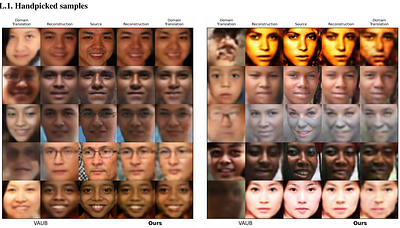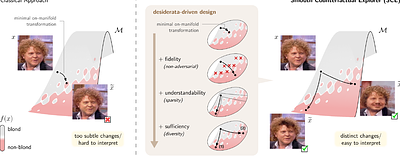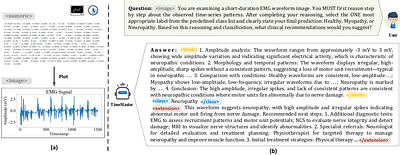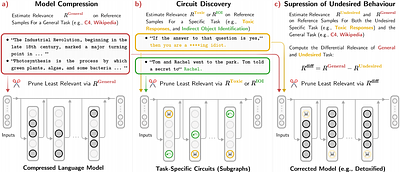Expressive Score-Based Priors for Distribution Matching with Geometry-Preserving Regularization
0upvotes
By: Ziyu Gong, Jim Lim, David I. Inouye
Distribution matching (DM) is a versatile domain-invariant representation learning technique that has been applied to tasks such as fair classification, domain adaptation, and domain translation. Non-parametric DM methods struggle with scalability and adversarial DM approaches suffer from instability and mode collapse. While likelihood-based methods are a promising alternative, they often impose unnecessary biases through fixed priors or requ... more
Distribution matching (DM) is a versatile domain-invariant representation learning technique that has been applied to tasks such as fair classification, domain adaptation, and domain translation. Non-parametric DM methods struggle with scalability and adversarial DM approaches suffer from instability and mode collapse. While likelihood-based methods are a promising alternative, they often impose unnecessary biases through fixed priors or require explicit density models (e.g., flows) that can be challenging to train. We address this limitation by introducing a novel approach to training likelihood-based DM using expressive score-based prior distributions. Our key insight is that gradient-based DM training only requires the prior's score function -- not its density -- allowing us to train the prior via denoising score matching. This approach eliminates biases from fixed priors (e.g., in VAEs), enabling more effective use of geometry-preserving regularization, while avoiding the challenge of learning an explicit prior density model (e.g., a flow-based prior). Our method also demonstrates better stability and computational efficiency compared to other diffusion-based priors (e.g., LSGM). Furthermore, experiments demonstrate superior performance across multiple tasks, establishing our score-based method as a stable and effective approach to distribution matching. Source code available at https://github.com/inouye-lab/SAUB. less
By: Mingkang Zhu, Xi Chen, Zhongdao Wang, Bei Yu, Hengshuang Zhao, Jiaya Jia
Recent advancements in reinforcement learning from human feedback have shown that utilizing fine-grained token-level reward models can substantially enhance the performance of Proximal Policy Optimization (PPO) in aligning large language models. However, it is challenging to leverage such token-level reward as guidance for Direct Preference Optimization (DPO), since DPO is formulated as a sequence-level bandit problem. To address this challen... more
Recent advancements in reinforcement learning from human feedback have shown that utilizing fine-grained token-level reward models can substantially enhance the performance of Proximal Policy Optimization (PPO) in aligning large language models. However, it is challenging to leverage such token-level reward as guidance for Direct Preference Optimization (DPO), since DPO is formulated as a sequence-level bandit problem. To address this challenge, this work decomposes the sequence-level PPO into a sequence of token-level proximal policy optimization problems and then frames the problem of token-level PPO with token-level reward guidance, from which closed-form optimal token-level policy and the corresponding token-level reward can be derived. Using the obtained reward and Bradley-Terry model, this work establishes a framework of computable loss functions with token-level reward guidance for DPO, and proposes a practical reward guidance based on the induced DPO reward. This formulation enables different tokens to exhibit varying degrees of deviation from reference policy based on their respective rewards. Experiment results demonstrate that our method achieves substantial performance improvements over DPO, with win rate gains of up to 7.5 points on MT-Bench, 6.2 points on AlpacaEval 2, and 4.3 points on Arena-Hard. Code is available at https://github.com/dvlab-research/TGDPO. less
By: Sidney Bender, Jan Herrmann, Klaus-Robert Müller, Grégoire Montavon
Visual counterfactual explainers (VCEs) are a straightforward and promising approach to enhancing the transparency of image classifiers. VCEs complement other types of explanations, such as feature attribution, by revealing the specific data transformations to which a machine learning model responds most strongly. In this paper, we argue that existing VCEs focus too narrowly on optimizing sample quality or change minimality; they fail to cons... more
Visual counterfactual explainers (VCEs) are a straightforward and promising approach to enhancing the transparency of image classifiers. VCEs complement other types of explanations, such as feature attribution, by revealing the specific data transformations to which a machine learning model responds most strongly. In this paper, we argue that existing VCEs focus too narrowly on optimizing sample quality or change minimality; they fail to consider the more holistic desiderata for an explanation, such as fidelity, understandability, and sufficiency. To address this shortcoming, we explore new mechanisms for counterfactual generation and investigate how they can help fulfill these desiderata. We combine these mechanisms into a novel 'smooth counterfactual explorer' (SCE) algorithm and demonstrate its effectiveness through systematic evaluations on synthetic and real data. less
5 SciCasts by .
By: Junru Zhang, Lang Feng, Xu Guo, Yuhan Wu, Yabo Dong, Duanqing Xu
Time-series reasoning remains a significant challenge in multimodal large language models (MLLMs) due to the dynamic temporal patterns, ambiguous semantics, and lack of temporal priors. In this work, we introduce TimeMaster, a reinforcement learning (RL)-based method that enables time-series MLLMs to perform structured, interpretable reasoning directly over visualized time-series inputs and task prompts. TimeMaster adopts a three-part structu... more
Time-series reasoning remains a significant challenge in multimodal large language models (MLLMs) due to the dynamic temporal patterns, ambiguous semantics, and lack of temporal priors. In this work, we introduce TimeMaster, a reinforcement learning (RL)-based method that enables time-series MLLMs to perform structured, interpretable reasoning directly over visualized time-series inputs and task prompts. TimeMaster adopts a three-part structured output format, reasoning, classification, and domain-specific extension, and is optimized via a composite reward function that aligns format adherence, prediction accuracy, and open-ended insight quality. The model is trained using a two-stage pipeline: we first apply supervised fine-tuning (SFT) to establish a good initialization, followed by Group Relative Policy Optimization (GRPO) at the token level to enable stable and targeted reward-driven improvement in time-series reasoning. We evaluate TimeMaster on the TimerBed benchmark across six real-world classification tasks based on Qwen2.5-VL-3B-Instruct. TimeMaster achieves state-of-the-art performance, outperforming both classical time-series models and few-shot GPT-4o by over 14.6% and 7.3% performance gain, respectively. Notably, TimeMaster goes beyond time-series classification: it also exhibits expert-like reasoning behavior, generates context-aware explanations, and delivers domain-aligned insights. Our results highlight that reward-driven RL can be a scalable and promising path toward integrating temporal understanding into time-series MLLMs. less
Attribution-guided Pruning for Compression, Circuit Discovery, and Targeted Correction in LLMs
0upvotes
By: Sayed Mohammad Vakilzadeh Hatefi, Maximilian Dreyer, Reduan Achtibat, Patrick Kahardipraja, Thomas Wiegand, Wojciech Samek, Sebastian Lapuschkin
Large Language Models (LLMs) are central to many contemporary AI applications, yet their extensive parameter counts pose significant challenges for deployment in memory- and compute-constrained environments. Recent works in eXplainable AI (XAI), particularly on attribution methods, suggest that interpretability can also enable model compression by identifying and removing components irrelevant to inference. In this paper, we leverage Layer-wi... more
Large Language Models (LLMs) are central to many contemporary AI applications, yet their extensive parameter counts pose significant challenges for deployment in memory- and compute-constrained environments. Recent works in eXplainable AI (XAI), particularly on attribution methods, suggest that interpretability can also enable model compression by identifying and removing components irrelevant to inference. In this paper, we leverage Layer-wise Relevance Propagation (LRP) to perform attribution-guided pruning of LLMs. While LRP has shown promise in structured pruning for vision models, we extend it to unstructured pruning in LLMs and demonstrate that it can substantially reduce model size with minimal performance loss. Our method is especially effective in extracting task-relevant subgraphs -- so-called ``circuits'' -- which can represent core functions (e.g., indirect object identification). Building on this, we introduce a technique for model correction, by selectively removing circuits responsible for spurious behaviors (e.g., toxic outputs). All in all, we gather these techniques as a uniform holistic framework and showcase its effectiveness and limitations through extensive experiments for compression, circuit discovery and model correction on Llama and OPT models, highlighting its potential for improving both model efficiency and safety. Our code is publicly available at https://github.com/erfanhatefi/SparC3. less
By: Runpeng Yu, Qi Li, Xinchao Wang
In this work, we provide a systematic survey of Discrete Diffusion Language Models (dLLMs) and Discrete Diffusion Multimodal Language Models (dMLLMs). Unlike autoregressive (AR) models, dLLMs and dMLLMs adopt a multi-token, parallel decoding paradigm using full attention and a denoising-based generation strategy. This paradigm naturally enables parallel generation, fine-grained output controllability, and dynamic, response-aware perception. T... more
In this work, we provide a systematic survey of Discrete Diffusion Language Models (dLLMs) and Discrete Diffusion Multimodal Language Models (dMLLMs). Unlike autoregressive (AR) models, dLLMs and dMLLMs adopt a multi-token, parallel decoding paradigm using full attention and a denoising-based generation strategy. This paradigm naturally enables parallel generation, fine-grained output controllability, and dynamic, response-aware perception. These capabilities are previously difficult to achieve with AR models. Recently, a growing number of industrial-scale proprietary d(M)LLMs, as well as a large number of open-source academic d(M)LLMs, have demonstrated performance comparable to their autoregressive counterparts, while achieving up to 10x acceleration in inference speed. The advancement of discrete diffusion LLMs and MLLMs has been largely driven by progress in two domains. The first is the development of autoregressive LLMs and MLLMs, which has accumulated vast amounts of data, benchmarks, and foundational infrastructure for training and inference. The second contributing domain is the evolution of the mathematical models underlying discrete diffusion. Together, these advancements have catalyzed a surge in dLLMs and dMLLMs research in early 2025. In this work, we present a comprehensive overview of the research in the dLLM and dMLLM domains. We trace the historical development of dLLMs and dMLLMs, formalize the underlying mathematical frameworks, and categorize representative models. We further analyze key techniques for training and inference, and summarize emerging applications across language, vision-language, and biological domains. We conclude by discussing future directions for research and deployment. Paper collection: https://github.com/LiQiiiii/DLLM-Survey less





